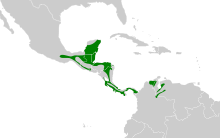Ruddy woodcreeper
| Ruddy woodcreeper | |
|---|---|

| |
| Scientific classification | |
| Kingdom: | Animalia |
| Phylum: | Chordata |
| Class: | Aves |
| Order: | Passeriformes |
| Family: | Furnariidae |
| Genus: | Dendrocincla |
| Species: | D. homochroa
|
| Binomial name | |
| Dendrocincla homochroa (Sclater, 1859)
| |

| |
The ruddy woodcreeper (Dendrocincla homochroa), is a passerine bird which breeds in the tropical New World from southern Mexico to northern Colombia and extreme northern Venezuela.
This woodcreeper is typically 20 cm (7.9 in) long and weighs 44 g (1.6 oz). It is almost entirely rufous, with a paler throat and grey line from the bill to the eye. The bill is longish and straight.
The call is a squeaky quink or loud deeah.
The ruddy woodcreeper is found in premontane humid forest in lowlands and foothills up to 1,600 m (5,200 ft),[2] and also in adjacent semi-open woodland and clearings.
Ruddy woodcreepers feed on spiders and insects. They will follow columns of army ants, sometimes in groups of up to three birds, dropping from saplings to catch prey fleeing the ants.
It builds a leaf-lined nest 0.6 to 5 m (2.0 to 16.4 ft) up in a hollow palm tree stump, and lays 2–3 white eggs. Adult birds also sleep alone in tree crevices.
Like other woodland birds, this species has been adversely affected by deforestation.[3] For example, in Colombia it is apparently common in the northwestern Sierra Nevada de Santa Marta, though otherwise a rather rare bird. This species apparently avoids human-altered habitat and secondary forest whenever possible. It is thus useful as a bioindicator.[2]
Nonetheless, it occupies a large range and wherever sufficient habitat remains, it is often not particularly uncommon. The IUCN considers it a Species of Least Concern.[1]
References[]
- ^ a b BirdLife International (2020). "Dendrocincla homochroa". IUCN Red List of Threatened Species. 2020: e.T22703026A138127572. doi:10.2305/IUCN.UK.2020-3.RLTS.T22703026A138127572.en. Retrieved 12 November 2021.
- ^ Steven L. Hilty (2003). Birds of Venezuela. Christopher Helm Publishers, Incorporated. ISBN 978-0-7136-6418-8.
- Stiles, F. Gary; Skutch, Alexander F. (1989). A Guide to the Birds of Costa Rica. Comstock Publishing Associates. ISBN 0-8014-9600-4.
External links[]
| Wikispecies has information related to Dendrocincla homochroa. |
- "Ruddy woodcreeper media". Internet Bird Collection.
- Ruddy woodcreeper photo gallery at VIREO (Drexel University)
- Ruddy woodcreeper species account at Neotropical Birds (Cornell Lab of Ornithology)
- Interactive range map of Dendrocincla homochroa at IUCN Red List maps
- IUCN Red List least concern species
- Dendrocincla
- Birds of Central America
- Birds of Colombia
- Birds of Venezuela
- Birds described in 1859
- Taxa named by Philip Sclater
